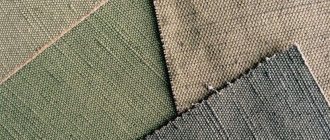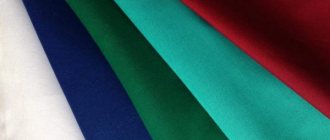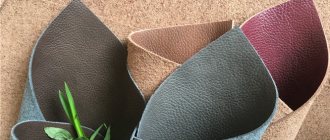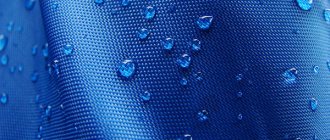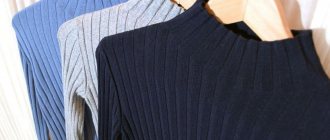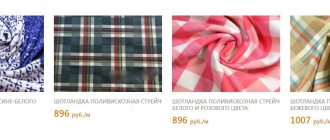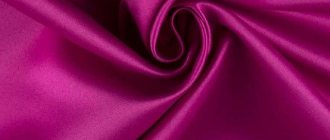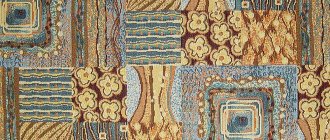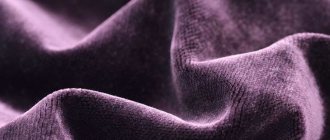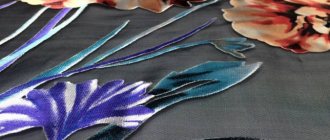Natural fabrics have always been popular due to their unique characteristics. Today, artificial materials are added to them, which help improve the properties of fabrics and give them new ones. All-natural wool with thin transparent silk are quite expensive types of textiles that differ in properties and fiber structure. Silk threads have high strength, while wool retains heat better and is more wear-resistant. Both types of matter are of animal origin, and therefore belong to natural materials for sewing clothes and home textiles.
Types and properties of wool and silk transparent fabrics
They are made from animal fibers. Silk is created from the material produced by silkworm cocoons, and wool is obtained from animals - goats, camels, sheep, alpacas. These materials differ in their composition. Find out about the characteristics and description of light fabric here.
Today, this composition of textiles is used for sewing coats and suits, albeit quite rarely.
What is the name of ancient thick woolen fabric mixed with fine silk?
An ancient dense woolen fabric, into which either silk or cotton fibers were mixed, was called camelot. It was always created on the basis of camel down. This fabric was usually used to make clothing. With cotton mixtures they were used to sew simple things for peasants. It was rough and easily wrinkled. At the same time, if silk fibers were added to the fabric, it became very soft, slightly loose. Quite expensive clothes for the nobility were made from it. Read about pleated fabric here.
Advantages and disadvantages
Wool has good heat-protective properties. It has increased density and low creasing. Therefore, a composition with 100% content of crimped thick fibers is often used to create winter clothing. These materials are durable, beautiful, have high wear resistance, and can be treated with moisture and heat.
Silk textiles are soft, pleasant to the touch, and have a certain degree of gloss. It is durable, lightweight, wrinkle-resistant, and beautiful. The material does not get dirty so quickly due to the smooth surface of the front side of the products and does not shrink. This article will tell you about the characteristics of the moleskin material.
Wool is characterized by increased dust holding capacity, and therefore products made from it have to be cleaned frequently. On the other hand, silk does not tolerate exposure to ultraviolet radiation, and in its pure form is quite expensive.
Despite the well-established opinion that wool is a fairly heavy, hot material, expensive varieties are no different from silk in terms of transparency.
Properties and quality
Things made from these materials have a number of distinctive properties:
- high degree of hygroscopicity;
- breathability;
- hygiene;
- high strength;
- naturalness of the composition.
A significant disadvantage of such textiles is the ability to shrink if not properly cared for, as well as the formation of pills.
Both materials differ in bactericidal properties. That is, microorganisms do not linger on the fibers of the threads, and therefore this type of textile will be in demand among people with excessive sweating and allergies. Find out about the composition and description of Dior fabric at this link.
Wool has healing properties, and therefore belts and knee pads are often made from it. They produce heat, static electricity, and local irritation. Therefore, it is often used in the treatment of inflammatory joint pathologies.
Depending on the type, as well as processing features and the presence of artificial fiber impurities in the composition, the properties of the material may vary.
Types of silk and scope of application
Types of silk fabrics have differences in the texture of the fabric, the quality of the fibers, and the weave of the threads. Below are the main types of silk.
Atlas
Satin weave is used in its production. It is a material whose front surface is smooth with a delicate shine, while the back remains rough.
Satin fabric is used mainly to create dresses for special occasions.
Charmeuse
Light and flowing material with a unique gloss, similar to satin, but lighter in weight. Charmeuse products look impressive.
Silk satin
It is a natural fabric with added cotton threads. Satin bed linen is in great demand because it is more durable, despite its low price.
Chiffon
Delicate, transparent and weightless material. Features of chiffon are softness, despite the rough structure.
Widely in demand for sewing scarves, blouses, and dressing gowns.
Gas
Airy, transparent matter. Silk gas is used for various purposes (from sewing light scarves, curtains and finishing elegant dresses).
Organza
The fabric is transparent and thin. Thanks to its rigidity, it holds its shape perfectly. Organza is used for sewing unique interior decor, concert costumes, and curtains.
Silk veil
Translucent, weightless fabric that can be printed, lace or embroidered. The material is used to decorate hairstyles and women's hats.
A bride's silk veil looks elegant and luxurious.
Taffeta
A type of shiny fabric produced by tightly twisting cotton and silk threads. It is resistant to shape due to its rigidity. Gives skirts fullness and volume. The material shimmers in the light, making it suitable for special occasions.
DuPont
The fabric has a slight sheen, is soft, heavy and dense. Premium class material is considered one of the most expensive. Choose DuPont for sewing unusual products.
Viscose
It belongs to the category of artificial fabric, which is obtained by mixing silk fiber and synthetics. Thanks to the latest technologies, viscose fabric is not inferior in quality to natural silk.
Wool and silk production
Pure silk is quite an expensive material, which is used for sewing luxury items and bed linen. But there are also analogues with impurities that make it possible for everyone to buy these textiles:
- Toile.
- Satin.
- Atlas.
- Crepe.
- Chiffon.
- Gas.
- Taffeta.
- Organza.
- Silk DuPont.
- Wild silk.
Clothing made from it has a glossy appearance and low heat-protective properties, which is why it is best worn in the warm season. Transparent thin silk fabric is highly durable. Its thread strength is comparable to steel wire of the same diameter. Wool is divided into the following subspecies:
- Velours.
- Felt.
- Tale.
- Gabardine.
- Cashmere.
- Cloth.
- Drap.
- Reps.
- Flannel and so on.
Naturally, heavy fabric with a pattern will cost a little more, but only if the quality of the material is appropriate.
Depending on the type of fiber, the cost of textiles will differ. The coloring of the product and the type of processing also affect the price of the material. This material will tell you about the types of linen fabric.
Types of silk fabrics and their applications
There are several types of silk fabrics depending on the type of fiber weave:
- Atlas. Fabric with a satin weave of warp and weft. The front side is shiny and very smooth to the touch. The reverse side is matte. It is used for sewing casual and dressy clothes, making shoes and accessories.
- Chiffon. Plain weave material. Soft, translucent, with a matte surface, rough to the touch. Blouses, shirts, and light dresses are made from it.
- Organza. Tough fabric that retains its shape well. This texture is obtained by tightly twisting the threads. It is often decorated with embroidery, sputtering, and etching. Evening dresses are most often made from it.
- Crepe. The fabric is rough to the touch due to the multidirectional twist of the threads. The fabric is thick, suitable for sewing suits.
Why are wool and silk fabrics so popular?
The popularity of materials of animal origin can easily be explained by their properties and characteristics:
- They are more pleasant to the body.
- Less likely to provoke allergic reactions.
- They have good wear resistance.
- They are distinguished by their medicinal properties, which are completely absent in artificial analogues.
The cost will depend on the type of finishing, creation technique, and weaving of threads.
To distinguish natural wool from artificial wool, it is enough to set fire to one thread. It flares up quickly, but burns for a long time.
Scope of application
Silk fabrics are used to make bedding, underwear, dresses, skirts, blouses, and home textiles. There are a lot of subspecies depending on the amount of impurities. Wool is used to create various types of clothing - from underwear to coats, as well as technical products such as burlap, ropes, and so on.
Pure wool is used to produce winter clothing.
Care instructions
Both types of materials require compliance with the following rules of care:
- Silk does not tolerate rough washing.
- This type of textile does not like exposure to ultraviolet light.
- It is better to use the “silk” mode for washing and ironing.
- No softeners or aggressive chemicals such as bleaches are used on silk fabrics.
- Wool should not be exposed to extremely high temperatures.
- Woolen fabrics do not tolerate rough washing or centrifuge drying, and may be subject to deformation and shrinkage.
- It is better to use special modes for washing in a machine, as well as chemicals intended for this.
In this way, it will be possible to maintain the original appearance of the item for a long time without deformation or signs of destruction of the material.
Results
These natural matters have become firmly established in everyday human life. They differ:
- Unique properties, hygiene, hygroscopicity and so on. Corduroy fabric is also hygroscopic.
- Requires careful handling and care.
- They are completely natural and of animal origin.
- Wool has pronounced medicinal properties, and silk has bactericidal properties.
- They are used for the production of various types of clothing, home and technical textiles.
- They have a lot of textile options, which differ in their parameters depending on the amount of impurities.
Silk textile fibers and fabrics
According to the classification given earlier, natural fibers of animal origin include natural silk and wool . Natural silk is the name given to fibers that are a product of the secretion of the silk glands of silkworm caterpillars. Silk obtained from silkworm caterpillars is mainly of industrial importance; to an incomparably lesser extent, but they still use the cocoons of oak silkworm caterpillars.
Sericulture (growing mulberry trees and breeding silkworms ) is a very ancient industry. The homeland of natural silk is China, where it was known even before our era. From China, silk spread to Japan, India, Western Asia and Southern Europe. In Tsarist Russia, sericulture developed in the regions of Central Asia and Transcaucasia, but the production of cocoons was carried out there in a handicraft way, and the silk-winding industry did not exist at all in Tsarist Russia. Therefore, cocoons were bought up and sent abroad for unwinding, from there in the form of raw silk they were imported back to Russia, where they were processed in textile factories into fabrics and other products. Today, state and collective farms in eleven republics of our country are engaged in sericulture. During the years of Soviet power, a powerful cocoon-winding industry and an industry processing raw silk into various products were created.
The silkworm goes through the following four stages of development: eggs (grena), caterpillar, pupa, butterfly.
In the spring, the butterfly lays eggs (grena), which are collected and, packed in boxes, stored until next spring. When leaves appear on the mulberry tree, the grena is revived in incubators. Caterpillars hatch from the testicles.
Feeding of caterpillars is carried out in worm ponds - premises specially equipped with multi-tiered racks. The growth of the caterpillar lasts 28-36 days, during which time its weight increases approximately 10,000 times.
Upon reaching adulthood, the caterpillar forms a thick mass of fibroin (the main substance of natural silk) and sericin (an adhesive substance) in the silk-secreting glands located on both sides of the body. The silk thread, which is obtained by separating this thick mass from the silk glands, consists of two silks connected to each other.
The caterpillar begins to curl the released thread into a cocoon . The curling of the cocoons lasts three days. After this, the caterpillar inside the cocoon sheds its skin and turns into a pupa.
The pupal stage lasts 2-2.5 weeks. Then the pupa turns into a butterfly. The latter leaves the cocoon, releasing a liquid that dissolves fibroin.
The cocoons from which the butterflies emerge are perforated and are therefore a waste product.
One box of greens (20-25 g) subsequently produces 80-85 kg of cocoons.
On the 8-9th day after the completion of curling, the cocoons are treated with steam or hot air (to kill the pupae) and dried.
Depending on the breed of silkworm and the conditions of its feeding, cocoons can have a spherical shape, oval, oval with a shallow or deep interception, with sharp ends. The length of the cocoons ranges from 25 to 45 mm, diameter - from 12 to 23 mm. The weight of wet cocoons is 1.2-3 g, dry 0.3-1 g. The color of cocoons is white, yellow in different shades, and less often - pink.
The length of the cocoon thread, depending on the breed of silkworm, the size and weight of the cocoon, can reach 1500 m; the length of the unwinding thread is 600-900 m. The average thickness of the cocoon thread ranges from 335 to 400 mtex (No. 2500-3000), breaking length is 22-27 km, elongation 13-20%. Sericin in cocoon shells contains from 24 to 29% (of the weight of the shell).
The thread unwound from one cocoon has strength insufficient for the production of fabrics. Therefore, raw silk (a technical thread used for industrial processing) is obtained by combining threads from several cocoons (from 4 to 20 pieces) into one thread.
Rejected cocoons - non-standard, holey - are turned into fibrous mass and processed into silk yarn , which is also used for the production of fabrics.
Cocoons are unwound in cocoon-winding production using special equipment (cocoon-winding basins and coco-winding machines) after preliminary steaming in special steaming chambers. The purpose of pre-steaming is to soften the sericin and make it easier for the cocoon thread to come off the cocoon. When unwinding cocoons, the resulting technical thread is wound onto a reel, forming skeins. When dried, the raw silk thread is firmly bound by sericin and becomes monolithic. During a shift on a reel, a skein of raw silk weighing from 40 to 130 g is obtained, depending on the thickness of the thread.
A thread of raw silk consists of a fibrous protein substance fibroin , which belongs to the class of scleroproteins, and a soluble silk glue covering the fibers - sericin. In addition to fibroin and sericin, the cocoon thread contains a certain amount of substances soluble in alcohol and ether, mineral salts and natural dyes. The content of substances included in the cocoon thread may vary depending on the breed and feeding conditions of the silkworm. Here are the approximate numbers (%): fibroin 70-80, sericin 20-25, substances soluble in alcohol and ether, 1.6-4, mineral substances 1-1.7.
The elemental composition of silk fibroin is as follows (%): carbon 48-49.1, hydrogen 6.4-6.51, nitrogen 17.36-18.89, oxygen 26-27.9. The elemental composition of sericin (%): carbon 44.32-46.29, hydrogen 5.72-6.42, nitrogen 16.44-18.3, oxygen 30.35-32.5, sulfur 0.15.
From the given figures it is clear that sericin differs from fibroin in lower carbon content and higher oxygen content. In addition, sericin contains a small amount of sulfur.
Different researchers obtained slightly different data on the composition of fibroin and sericin. These differences can be explained by the fact that both fibroin and sericin in the cocoons of different breeds of silkworms are not identical in their chemical composition and properties.
- Back
- Forward
